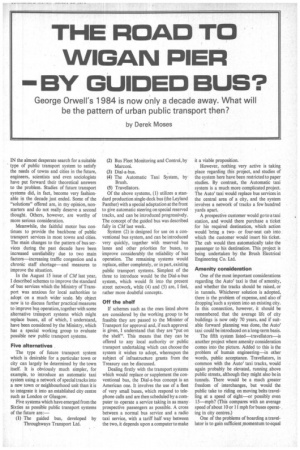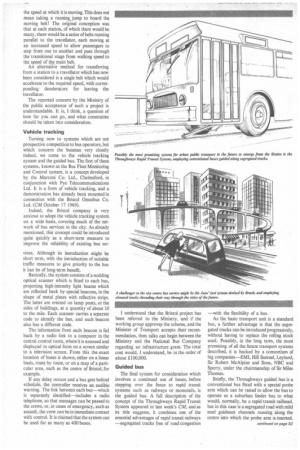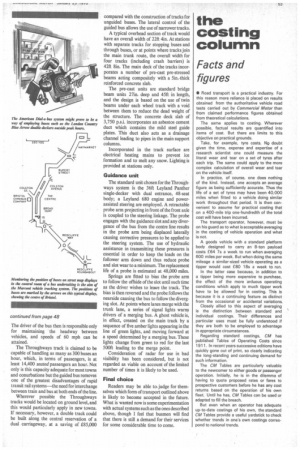THE ROAD TO WIGAN PIER BY GUIDED BUS?
Page 49

Page 50

Page 55

If you've noticed an error in this article please click here to report it so we can fix it.
George Orwell's 1984 is now only a decade away. What will be the pattern of urban public transport then?
by Derek Moses
IN the almost desperate search for a suitable type of public transport system to satisfy the needs of towns and cities in the future, engineers, scientists and even sociologists have put forward their theoretical answers to the problem. Studies of future transport systems did, in fact, become very fashionable in the decade just ended. Some of the "solutions" offered are, in my opinion, nonstarters and do not really deserve a second thought. Others, however, are worthy of more serious consideration.
Meanwhile, the faithful motor bus continues to provide the backbone of public transport services in most towns and cities. The main changes to the pattern of bus services during the past decade have been increased unreliability due to two main factors—increasing traffic congestion and a chronic staff shortage—and measures to improve the situation.
In the August 15 issue of CM last year,
I described schemes to improve the standard of bus services which the Ministry of Transport was anxious for local authorities to adopt on a much wider scale. My object now is to discuss further practical measures to improve bus operation, together with some alternative transport systems which might replace buses, all of which, I understand, have been considered by the Ministry, which has a special working group to evaluate possible new public transport systems.
Five alternatives
The type of future transport system which is desirable for a particular town or city can largely be determined by the town itself. It is obviously much simpler, for example, to introduce an automatic taxi system using a network of special tracks into a new town or neighbourhood unit than it is to integrate it into an established city centre such as London or Glasgow.
Five systems which have emerged from the Sixties as possible public transport systems of the future are:—
(1) The guided bus, developed by Throughways Transport Ltd. (2) Bus Fleet Monitoring and Control, by Marconi.
(3) Dial-a-bus.
(4) The Automatic Taxi System, by Brush.
(5) Travellators.
Of the above systems, (1) utilizes a standard production single-deck bus (the Leyland Panther) with a special adaptation at the front to give automatic steering on special reserved tracks, and can be introduced progressively. The concept of the guided bus was described fully in CM last week.
System (2) isdesigned for use on a conventional bus system, and can be introduced very quickly, together with reserved bus lanes and other priorities for buses, to improve considerably the reliability of bus operation. The remaining systems would replace, either completely, or in part, existing public transport systems. Simplest of the three to introduce would be the Dial-a-bus system, which would fit into the present street network, while (4) and (5) are, I feel, rather more doubtful concepts.
Off the shelf
If schemes such as the ones listed above are considered by the working group to be feasible they are passed to the Minister of Transport for approval and, if such approval is given, I understand that they are "put on the shelf". This means that they can be offered to any local authority or public transport undertaking which can choose the system it wishes to adopt, whereupon the subject of infrastructure grants from the Treasury can be discussed.
Dealing firstly with the transport systems which would replace or supplement the conventional bus, the Dial-a-bus concept is an American one. It involves the use of a fleet of very small buses, which respond to telephone calls and are then scheduled by a computer to operate a service taking in as many prospective passengers as possible. A cross between a normal bus service and a radio taxi service, with a tariff half way between the two, it depends upon a computer to make it a viable proposition.
However, nothing very active is taking place regarding this project, and studies of the -system here have been restricted to paper studies. By contrast, the Automatic taxi system is a much more complicated project. The Auto' taxi would replace bus services in the central area of a city, and the system involves a network of tracks a few hundred yards apart.
A prospective customer would go to a taxi station, and would there purchase a ticket for his required destination, which action would 'bring a twoor four-seat cab into which the customer would insert his ticket. The cab would then automatically take the passenger to his destination. This project is being undertaken by the Brush Electrical Engineering Co. Ltd.
Amenity consideration
One of the most important considerations regarding the Auto' taxi is that of amenity, and whether the tracks should be raised, or in tunnels. Whichever solution is adopted, there is the problem of expense, and also of dropping-such a system into an existing city. In this connection, however, it should be remembered that the average life of city buildings is now only 70 years, and if suitable forward planning was done, the Auto' taxi could be introduced on a long-term basis.
The fifth system listed—travellators—is another project where amenity consideration comes into the picture. Added to this is the problem of human engineering—in other words, public acceptance. Travellators, in common with the Auto' taxi tracks, would again probably be elevated, running above public streets, although they might also be in tunnels. There would be a much greater freedom of interchanges, but would the public take to riding on moving belts travelling at a speed of eight—or possibly even 15—mph? (This compares with an average speed of about 10 or 11 mph for buses operating in city centres.) One of the problems of boarding a travellator is to gain sufficient Jnomenttun to equal
the speed at which it is moving. This does not mean taking a running, jump to board the moving belt! The original conception was that at each station, of which there would be many, there would be a series of belts running parallel to the travellator, each moving at an increased speed to allow passengers to step from one to another and pass through the transitional stage from walking speed to the speed of the main belt.
An alternative method for transferring from a station to a travellator which has now been considered is a single belt which would accelerate to the required speed, with corresponding decelerators for leaving the travellator.
The reported concern by the Ministry of the public acceptance of such a project is understandable. It is, I think, a question of how far you can go, and what constraints should be taken into consideration.
Vehicle tracking Turning now to systems which are not prospective competition to bus operators, but which concern the busman very closely indeed, we come to the vehicle tracking system and the guided bus. The first of these systems. known as the Bus Fleet Monitoring and Control system, is a concept developed by the Marconi Co. Ltd.. Chelmsford, in conjunction with Pye Telecommunications Ltd. It is a form of vehicle tracking, and a demonstration has already been mounted in connection with the Bristol Omnibus Co. Ltd. (CM October 17 1969).
Indeed, the Bristol company is very anxious to adopt the vehicle tracking system on a wide basis, covering much of the network of bus services in the city. As already mentioned, this concept could be introduced quite quickly as a short-term measure to improve the reliability of existing bus ser vices. Although its introduction might be short term, with the introduction of suitable traffic measures to give priority to the bus it Can be of long-term benefit.
Basically, the system consists of a nodding optical scanner which is fitted to each bus, projecting high-intensity light beams which are reflected back by special beacons, in the shape of metal plates with reflective strips. The latter are erected on lamp posts, or the sides of buildings, at a quantity of about 10 to the mile. Each scanner carries a separate code to identify the bus, and each beacon also has a different code.
The information from each beacon is fed back by a radio link to a computer in the central control room, where it is assessed and displayed in optical form on a screen similar to a television screen. From this the exact location of buses is shown, either on a linear basis, route by route, or on a map of a particular area, such as the centre of Bristol, for example.
If any delay occurs and a bus gets behind schedule, the controller receives an audible warning. The link between each bus—which is separately identified—includes a radio telephone, so that messages can be passed to the crews, or, in cases of emergency, such as assault, the crew can be in immediate contact with control. It is claimed that the system can be used for as many as 400 buses. I understand that the Bristol project has been referred to the Ministry, and if the working group approves the scheme, and the Minister of Transport accepts their recommendation, then talks can begin between the Ministry and the National Bus Company regarding an infrastructure grant. The total cost would, I understand, be in the order of about £100,000.
Guided bus The final system for consideration which involves a continued use of buses, before stepping over the fence to rapid transit systems such as railways or monorails, is the guided bus. A full description of the concept of the Throughways Rapid Transit System appeared in last week's CM, and as its title suggests, it combines one of the essential advantages of rapid transit railways —segregated tracks free of road congestion —with the flexibility of a bus.
As the basic transport unit is a standard bus, a further advantage is that the segregated tracks can be introduced progressively, without having to replace the rolling stock used. Possibly, in the long term, the most promising of all the future transport systems described, it is backed by a consortium of big companies—EMI, Hill Samuel, Leyland, Sir Robert McAlpine and Sons, NBC and Sperry, under the chairmanship of Sir Miles Thomas.
Briefly, the Throughways guided bus is a conventional bus fitted with a special probe arm which can be raised to allow the bus to operate as a suburban feeder bus to what would, normally, be a rapid transit railhead, but in this case is a segregated road with mild steel guidance channels running along the centre into which the probe arm is inserted.
The driver of the bus then is responsible only for maintaining the headway between vehicles, and speeds of 60 mph can be attained.
The Throughways track is claimed to be capable of handling as many as 300 buses an hour, which, in terms of passengers, is at least 14,400 seated passengers an hour. Not only is this capacity adequate for most towns and conurbations but the guided bus removes one of the greatest disadvantages of rapid transit rail systems—the need for interchange between train and bus at both ends of the line.
Wherever possible the Throughways tracks would be located on ground level, and this would particularly apply in new towns. If necessary, however, a double track could be built along the central reservation of a dual carriageway, at a saving of £85,000 compared with the construction of tracks for unguided buses. The lateral control of the guided bus allows the use of narrower tracks.
A typical overhead section of track would have an overall width of 22ft 4in. At stations with separate tracks for stopping buses and through buses, or at points where tracks join the main trunk route, the overall width for four tracks (including crash barriers) is 42f1 8in. The main deck of the tracks incorporates a number of pre-cast pre-stressed beams acting compositely with a 5in.-thick reinforced concrete slab.
The pre-cast units are standard bridge beam units 27in. deep and 45ft in length, and the design is based on the use of twin beams under each wheel track with a void between them to reduce the dead weight of the structure. The concrete deck slab of 3,750 p.s.i. incorporates an asbestos cement duct which contains the mild steel guide plates. This duct also acts as a drainage channel leading to pipes in the main support columns.
Incorporated in the track surface are electrical heating mains to prevent ice formation and to melt any snow. Lighting is provided at stations only.
Guidance unit The standard unit chosen for the Throughways system is the 36ft Leyland Panther single-decker with dual entrance, 48-seat body; a Leyland 680 engine and powerassisted steering are employed. A retractable probe arm projecting in front of the front axle is coupled to the steering linkage. The probe engages with the guidance slot and any divergence of the bus from the centre line results in the probe arm being displaced laterally causing corrective pressures to be applied to the steering system. The use of hydraulic assistance in transmitting these pressures is essential in order to keep the loads on the follower arm down and thus reduce probe and slot wear to a minimum. The replacement life of a probe is estimated at 48,000 miles.
Springs are fitted to bias the probe arm to follow the offside of the slot until such time as the driver wishes to leave the track. The bias is then reversed and the probe follows the nearside causing the bus to follow the diverging slot. At points where lanes merge with the trunk lane, a series of signal lights warns drivers of a merging bus. A ghost vehicle is, in effect, created on the main track by a sequence of five amber lights appearing in the line of green lights, and moving forward at a speed determined by a merging bus. These lights change from green to red for the last 500ft leading to the merge point.
Consideration of radar for use in bad visibility has been considered, but is not regarded as viable on account of the limited number of times it is likely to be used.
Final choice Readers may be able to. judge for themselves which form of transport outlined above is likely to become accepted in the future. What is wanted now is some experimentation with actual systems such as the ones described above, though I feel that busmen will find that there is still a demand for their services for some considerable time to come.








































































































